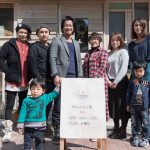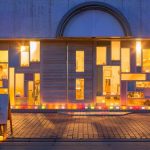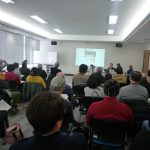原子力発電所と共存するコミュニティで“記憶”と“記録”について考える
~The town where no one lived, but this is still our homeland~ Afterimages in a community with a nuclear power plant (Tomioka, Fukushima Pref.)

福島県の東部、太平洋に面する富岡町。首都圏から約250キロの場所にある海沿いののどかな町は2011年3月、東京電力福島第一原子力発電所事故により町の風景が一変しました。かつて帰還困難区域となっていた地域の解除が現在進み、市街地にはレストランなどがオープン、また、津波で家などが全壊した沿岸部には共同住宅が建てられ、進入禁止のバリケードがあった時期と比べると街の雰囲気はだいぶ変わりました。
Tomioka, facing the Pacific Ocean in the eastern part of Fukushima Pref., is a quiet seaside town located approx. 250 km northward from Tokyo. Due to the 3.11 disasters and the accident of the Fukushima Daiichi NPP, it was dramatically changed and when barricades were in place not to accept people.

今回ではその中でも行政施設や病院が集まる地域に建てられた「とみおかアーカイブミュージアム」についてご紹介いたします。
In this issue, I’d like to write about the “The Historical Archive Museum Of Tomioka”.

2021年にオープンしたこのミュージアムは富岡町の歴史を伝える資料や文化財のほか、町に福島第二原子力発電所が設置されるまでの経緯とその後、そして、震災の記録を伝える常設展を行っています。
Opened in 2021, the museum collects documents and cultural assets that inherit the history of Tomioka, as well as permanent exhibitions that show how the Fukushima Daini NPP was built in the town and what happened afterwards, and records of the 3.11 disaster.


震災前、こうした展示物の多くはなにげない日常の光景の一部でしたが、震災後は「災害廃棄物」「汚染ガレキ」と区別されて行き場を失う状況に。
Many of these were one of the normal daily scenes until the disaster, however they were called “Disaster dangerous waste” or “Contaminated debris” after and be hated.

震災から10年余の紆余曲折を経て、「資料」として収集された“当たり前”を目の当たりにすると、地域の日常が深く刻まれた品を地元の博物館が残していくということの意義を強く感じざるを得ません。
When we see the “ordinary” goods collected as “materials” after more than 10 years of twists and turns since the disaster, we cannot help but feel the significance of a local museum preserving items that are deeply etched in the daily lives of the community.
記憶というのはそもそも個人の脳裏にありますが、被災者が身につけていたものやメモ書き壊れた時計などや経験した個人的な記録を見た時にそれがどのような過去を物語っているのかと想像することで、震災を経験した人々の記憶に我が事として受け入れられるような気がします。
Memories are in the minds of individuals, but when we look at what survivors’ clothes, notes, broken clocks, and other personal records of their experiences, we can imagine what they tell us about their past. Then, we can accept the memories of those who experienced the disaster as our own.

世界中に災害や戦争をテーマにした施設や負の遺産を伝承する「ダークツーリズム」はありますが、背後には犠牲になった命もあれば、偶然にも削ぎ落とされずに後世に残された貴重な資料もあります。今となっては東日本大震災の被災地にモノやコトを伝承するための施設が増え、震災と地域史と完全に分けて展示する施設がほとんどの中、富岡のように震災の記憶を残す被災した資料と町の歴史を伝える文化財を同じ空間に展示する施設はあまりありません。言い換えれば、わたしたちが今どの時系列にあるのか視認できる施設は貴重な施設とも言えます。
We have disaster- or war-themed facilities and “dark tourism” around the world, but behind them there are lives that were sacrificed and valuable materials that happened to be left behind for future generations without being scrubbed away. Nowadays, there are more and more facilities in the areas affected by the 3.11 disaster to hand down the experiences, and while most of them exhibit the disaster and local history completely separately, there are not many facilities like the ones in Tomioka that exhibit the damaged materials that preserve the memory of the disaster and the cultural assets that tell the history of the town in the same space. In other words, a facility that allows visitors to see the timeline of the disaster is a valuable asset.
復興庁と自治体が避難世帯向けに実施した2019年度の調査では、5割弱の住民が「戻らない」と回答した富岡町。未来は決して明るくはありません。避難者が地元に戻る可能性が増える見込みもない中で、地域の歴史をどう紡いでいくか、こういう町がいま日本に実際にあることを「知る」ことも復興のひとつだと願ってやみません。
According to the survey conducted in 2019, nearly 50% of the residents chose “No return” to Tomioka. With no hope of the evacuees returning to their hometowns, we can only hope that one part of the recovery process will be to learn that such a town actually exists in Japan, and how to weave together the history of the region.




